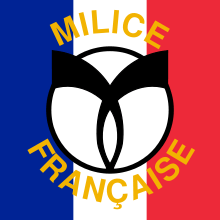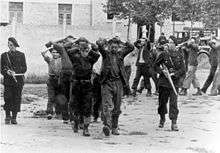Franc-Garde
| Franc-Garde | |
|---|---|
 Flag with the Milice's gamma symbol. | |
| Active | 1943-44 |
| Country |
|
| Allegiance |
|
| Type | Armed militia |
| Role | To support the Révolution nationale |
| Size | 4000 |
The Franc-Garde (English: Free Guard) was the armed wing of the French Milice (Militia) and was taken alone or alongside German forces in major battles against the Maquis from late 1943 to August 1944.
History
The creation of the Franc-Garde was announced on 30 January 1943 and it was deployed June 2 of the same year in Calabria camp near Vichy with Jean de Vaugelas serving as its commander. This group was successful in its recruitment because the volunteers were promised a salary of 3,600 francs.[1] By 1944, the auxiliary group swelled to 131 men,[1] and it was mostly composed of young fighters.[2] Once it saw action, the Franc-Garde immediately became the most important connecting link to the SS.[3] Some of its members were also documented serving in the 1945 battle of Berlin, taking part in the defense of the city's government district.[3]
The Milice also used the group as a recruitment ground for volunteers who will serve in the Waffen SS, particularly those that would be deployed in the SS Charlemagne Division. This recruitment earned the Milice light arms that were used within France.
Its field of action, initially confined to the former free zone, was formally extended to the former occupied zone as of January 27, 1944. His role was to support the national revolution undertaken by the Vichy government in predominantly involved in policing, but also assisting, inter alia, the clearing of bombed cities. In the words of Secretary General of the French Militia, Joseph Darnand, in his keynote address January 30, 1943, the Franc-Garde should be "educated and technically prepared to fight to be always ready to maintain the order ". It was his review: The Assault.
The Franc-Garde consisted of two parts:
- Free-Standing Garde, cantoned and unpaid, and
- the franc-Garde volunteer, whose members, militiamen ordinary screened, could be mobilized through precise and timely action when summoned.
The first two were trained thirty piloted in cities where dissent was the most active: Lyon and Annecy. The names of thirty hundred and should not be misled on the real effective. For example, the trentaine d'Annecy, became hundred, had only 72 men in May 1944. According to the Information Service of the French Committee of National Liberation in February 1944, the Franc-Garde men gathered in 1687, a cohort in Vichy, a hundred in Lyon, Marseille and Toulouse, and thirty in each of forty-five departments of the south. In any case, even with the mobilization of volunteers in the spring and summer 1944, the size of the Franc-Garde never exceeded 4,000 men.
In principle, any intervention by the Free Guard should be preceded by a verbal or written requisition sent by the prefect to the officer commanding the unit required, which was not always the case in practice.
In October - November 1944, facing the advance of allied troops, thousands of militiamen (10 to 15 000 active militants) left the national territory. Among them, about 2,500 franc-gardes were declared fit to fight:
- 1800 were sent to the camp Lager Heuberg[4] near the city of Ulm in Germany where they were located within the 57th SS Infantry Regiment, formed by survivors of the LVF, and in the 58th SS Infantry Regiment formed by survivors of the Sturmbrigade Frankreich, in the context of the 33rd SS Grenadier Division Charlemagne.
- 500 others formed a battalion of infantry, under the direct command of the naval officer Carus, former head of staff of the Militia, who will fight Italian partisans alongside the fascists RSI in Northern Italy.
Organization and equipment

The Franc-Garde consisted of volunteers (typically enrolled after a year's membership in the Militia), aged 18 to 45 years old, who lived in barracks and were paid based on the official salary of a sergeant of the Police National.
- Organisation:
- main (hand) consisting of a chief and four men;
- dizaine (ten) (corresponding to the combat group);
- trentaine (thirty) a small section - in principle at least one in each capital of province;
- centaine (hundred) a small company - in principle at least one in each capital city region. There were two types:
- "normal" - traveling on foot or bicycle and
- "mobile" - with motorbikes, cars and trucks;
- cohorte (cohort) a small battalion of three hundred;
- Centre (center) a small regiment of several cohorts.
- Uniform:
The Francs-Gardes, the only militia in uniform, adopted the dark blue dress Alpine model 1941 ("ski" trousers worn with gaiters and boots, jacket and belt, khaki shirt, black tie, beret tilted to the left).
The symbol of a white Greek letter gamma, on black, was used in a metal badge worn in the right buttonhole and in an embroidered badge on the beret. In combat situations, usually in the fight against the guerrillas, the Franc-garde could wear an Adrian helmet.
- Armament:
Because of the reluctance of the German Army, the Franc-Garde was only slowly and gradually armed. Its officers had pistols from the outset, but it was not until autumn 1943, following the upsurge in attacks against its members, that the Franc-Garde received some pistols recovered from British drops to the Resistance. In January 1944 the Franc-Garde was authorized to draw on stockpiles of arms built up after the military armistice, and in March 1944 it was authorized to form a section of machine guns and mortars to participate in the attack on the wooded country of Glières. Finally, each Ten was equipped with two Sten submachine guns, the French MAC 24/29 machine gun and MAS 36 rifles. Following a German refusal, the Franc-Garde could never get heavy weapons, artillery or armored vehicles.
In 1944, a Franc-Garde school was set up in Poitiers.[5]
Notes and references
- 1 2 Ott, Sandra (2017). Living with the Enemy. Cambridge: Cambridge University Press. p. 74. ISBN 9781107178205.
- ↑ Kundahl, George (2017). Riviera at War: World War II on the Côte d'Azur. London: I.B. Tauris & Co. Ltd. p. 5. ISBN 9781784538712.
- 1 2 Seibel, Wolfgang (2016). Persecution and Rescue: The Politics of the “Final Solution” in France, 1940-1944. Ann Arbor: University of Michigan Press. p. 98. ISBN 9780472118601.
- ↑ See entry of one fallen or deceased soldier of the "Marsch-Btl. Franc Garde" in the following two lists. First list: Kriegsgraeber Ehrenfriedhof A, B, C, E Nr. B 58, Friedhofsamt Tuebingen, and second list: Oeffentliche Kriegsgraeberliste vom 11. Januar 1954, Friedhofsamt Tuebingen.
- ↑ Jean-Henri Calmon, Occupation, Résistance et Libération dans la Vienne en 30 questions , Geste éditions, coll. (Occupation, Resistance and Liberation in Vienna in 30 questions), Jean-Clément Martin (ed.), The Nativity, 2000, 63 p. ( ISBN 2-910919-98-6), p 41
Sources and bibliography
- Jacques Delperrié de Bayac, Histoire de la Milice, 1918–1945, (History of the Militia, 1918–1945), Fayard, 1969, reprinted in paperback Marabout.
- Pierre Giolitto, Histoire de la Milice, (History of the Militia), Editions Perrin, collection Tempus, 2002.
- David Littlejohn, Foreign Legions of the Third Reich (volume 1), James Bender Publishing, USA 1987 .
- Pascal Ory, Les Collaborateurs 1940-1945, éditions du Seuil, 1976 . Pascal Ory, Les Contributors 1940-1945, Editions du Seuil, 1976.
See also
| Wikimedia Commons has media related to World War II France Milice. |